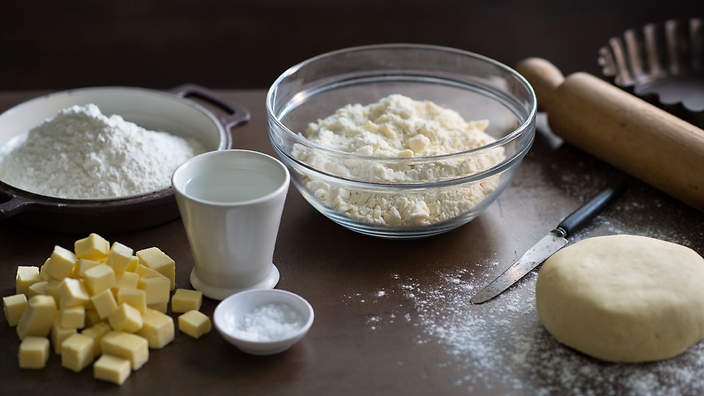Shortcrust_pastry
Shortcrust Pastry

Shortcrust pastry, when you have a good recipe, is one of the simplest and quickest pastries to make. Here, I’ve given lots of tips and direction about how to use and cook your pastry, as well as three great variations to use in a variety of both sweet and savoury tarts and pies.
Yield 1
Ingredients
- 225 g (11/2 cups) plain flour
- 1 good pinch salt
- 150 g chilled unsalted butter, diced
- 2 to 2 1/2 tbsp iced water
Instructions
Chilling time 20 minutes
This recipe makes enough for a 23cm round tart case, a 24cm square tart case, 10 x 6cm individual tart cases, a 31cm x 10cm tart case or 24 tartlet cases (1 tablespoon capacity). Place the flour and salt in a medium mixing bowl. Add the chilled butter. With your palms facing upwards, use your fingertips to rub in the butter until the mixture resembles coarse breadcrumbs.
Sprinkle 2 tablespoons of the iced water over the flour and butter mixture. Use a round-bladed knife in a cutting motion to mix until evenly combined and the mixture starts holding together.
Press a little of the mixture between your fingers: if it holds together easily, there is no need to add more water. If it doesn’t, add the remaining 1/2 tbsp water and combine. The pastry should be soft but not sticky. Bring the pastry together with your hands and transfer to a lightly floured, cool benchtop.
Lightly knead the pastry with your fingertips for about 30 seconds or until smooth and soft. Shape the pastry into a disc, wrap well in plastic wrap and place in the fridge for 20 minutes to rest.
Baker’s tips
Making ahead - This pastry (and all the variations below) can be made up to 3 days before using.
Wrap well in plastic wrap and keep in the fridge. Stand at room temperature for 20-60 minutes (depending on the weather) until softened slightly, enough to roll easily. Freezing uncooked pastry - Shape pastry into a disc.
Wrap well in plastic wrap, then seal in a freezer bag or airtight container and freeze for up to 1 month.
Transfer to the fridge to thaw completely (this will take about 1 day). Stand at room temperature for 20-60 minutes (depending on the weather) until softened slightly, enough to roll easily.
Freezing uncooked pastry case/s - Place the pastry cases, still in the tin/s in the freezer until frozen. Either leave in tin/s or remove and seal in freezer bag/s or airtight container/s. Freeze for up to 1 month. Cook directly from the freezer or transfer to the fridge to thaw completely (this will take about 1 day) and blind bake or cook as directed in the recipe.
Lining a tart tin
Unwrap the pastry and place on a lightly floured, cool work surface. Gently pat the pastry with the palm of your hand to flatten slightly.
Use a lightly floured rolling pin to roll the pastry into a disc about 3-5mm thick.
Always roll from the centre of the pastry outwards and in the same direction, giving the pastry a quarter turn after each roll so that it rolls evenly and doesn’t stick to the bench. Be careful not to use too much flour or the pastry will become dry.
Carefully drape the pastry loosely around the rolling pin. Place it over an ungreased tart tin with a removable base and then unroll the pastry, being careful not to stretch it. Gently lift the edge of the pastry and ease it into the tart tin to line the base and sides, and settle it into the corners.
Use your fingertips to press it gently into the corners without stretching it. Then, working around the tin, press the pastry into the side using your thumb or finger. Roll the rolling pin over the top of the tart tin to trim any overhanging pastry. Chill for 30 minutes.
Blind baking a pastry case
Preheat oven to 200°C.
Place the uncooked pastry base in the tart case/s on a baking tray.
Prick the pastry base with a fork (about 12 times for a 23cm round case). This will help the pastry case from “bubbling” during baking. Line the pastry case with non-stick baking paper and fill with pastry weights, dried beans or raw rice, making sure they press into the corners.
Bake in preheated oven for 15 minutes. Remove from oven and use the paper to lift the weights out of the case.
Return the pastry case to the oven and cook for a further 5 minutes for a partially cooked pastry case or 10-12 minutes for a fully cooked pastry case.
Remove the tart case from the oven and cool in the tin on a wire rack, or fill and return to the oven if directed.
Cheat’s blind baking
You can blind bake a pastry case without using paper or weights. Simply place the pastry-lined tin in the freezer for 30 minutes. Bake for the total blind baking time.
This no-fuss Method works particularly well for small pastry cases that are hard to line and weigh.
Making shortcrust pastry in a food processor
This Method is simple and super quick. Just make sure you don’t overwork the mixture. Put the flour, salt and chilled butter in the bowl of a food processor.
Use the pulse button to process until the mixture resembles coarse breadcrumbs. Sprinkle over the water/whisked egg yolk and use the pulse button to process briefly until the mixture just starts to cling together (don’t let it form a ball).
Turn the dough out onto a lightly floured, cool benchtop. Lightly knead the pastry with your fingertips for about 30 seconds or until smooth and soft. Shape the pastry into a disc, wrap well in plastic wrap and place in the fridge for 20 minutes to rest.